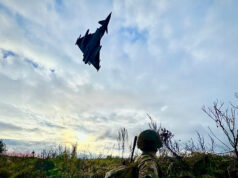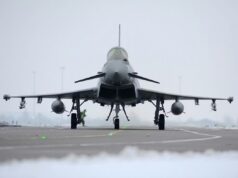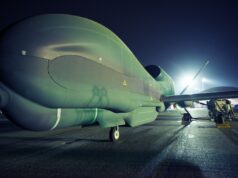The UK has confirmed a significant acceleration of its directed energy weapons (DEW) programme, including continued development of the DragonFire laser system and radio-frequency (RF) weapons, following successful trials and a new commitment of nearly £1 billion in funding.
In a written response to a parliamentary question from James Cartlidge MP, Defence Minister Maria Eagle outlined the Government’s renewed focus on novel weapons technology as part of the implementation of the Strategic Defence Review. The minister described the new investment as a step that would position the UK “at the leading edge of innovation and novel capabilities within NATO.”
Directed energy weapons, which include high-energy lasers and radio-frequency systems designed to disable or destroy targets without conventional explosives, are being developed to counter threats such as drones, missiles and potentially crewed aircraft. The Ministry of Defence has placed particular emphasis on the use of these systems to protect UK Armed Forces both at home and overseas.
In her written answer, Eagle confirmed that a recent trial of a radio frequency DEW demonstrator with the British Army had successfully engaged and neutralised drone targets. She also reported strong progress with the DragonFire laser system, the UK’s flagship DEW programme, noting that the latest round of testing had seen the system fire more than 300 times.
These firings, Eagle said, had “proved consistency and reliability,” including “30 drone defeats and firings in adverse weather conditions.” The tests, which took place under operationally relevant circumstances, are part of a broader effort to gather “vital evidence and learning needed to improve and adapt these systems,” she added.
DragonFire, a collaboration between the Defence Science and Technology Laboratory (Dstl), MBDA, Leonardo and QinetiQ, is designed to deliver a precision laser capable of engaging airborne threats at operational ranges, with low cost per shot and minimal logistical burden compared to traditional kinetic interceptors.
The broader DEW effort is now seen as a key enabler of future force protection. Eagle noted that the systems under development would be suited to “multiple military use cases,” including base defence and protection of high-value assets. However, she declined to offer specifics on deployment timelines or locations, citing operational security concerns.
The £1 billion in new funding will support ongoing trials, rapid prototyping and eventual fielding of laser and RF systems. This level of investment, Eagle said, reflects a wider strategic shift within the Ministry of Defence to accelerate innovation and modernise UK defence capabilities in line with rising global threats.
While laser and DEW technologies remain in the advanced testing and pre-operational phase, their growing maturity and proven performance against drones, one of the most prevalent threats in modern battlefields, is likely to prompt greater emphasis on their role in UK force structure planning.
The update comes amid broader NATO efforts to ramp up investment in next-generation capabilities, with Allies at the recent NATO Summit in The Hague pledging to meet significantly expanded capability targets. For the UK, directed energy is now viewed as one of the core technologies for achieving high-readiness, low-footprint defence systems capable of defeating evolving threats quickly and economically.














I welcome this development. It is absolutely imperative to get these systems fitted to ships and bases as soon as possible, but let’s not stop there. In the UK, there are many many elements of Civil infrastructure that are critical to the day to day functioning of the Nation that also need to be properly defended. The Government has after all, announced a commitment to go to 5% of GDP on defence spending, wider homeland security and national resilience.
So we have accelerated from all stopped to dead slow ahead?
Is this the same acceleration that was in the news some weeks ago? Or something additional?
No it’s been ramped up to 11.
Based on the £11 Rachael found in the tea money tin for defence, short term exceptional funding you understand, having been spent on 18 new projects totalling 5 gazillions…..
It is one of defences great superpowers New Math……
Knowing past form, just the usual re-announcing for political grandstanding reasons.
Was it 1 billion for a handful of systems?
We don’t know how to accelerate
We aren’t but bae are triple charging everyone for the same research
Can DragonFire be used at sea level? If sea level; ground level; yikes! Bring on the tripods.
Where will the DF assembly be sited on the T45? Guessing something will have to come off – if so, what? And, critically, is there sufficient electrical power generation on board to support multiple fires? If not, CIWS seems a more cost-effective option in the short-term 🧐